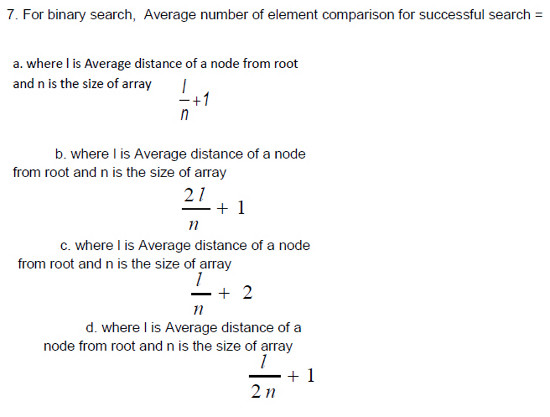All solutions to the 8-queens problem can be represented as...
A procedure, which can call …………., is said...
The travelling salesperson problem is to find a tour of...
A feasible solution that either maximizes or minimizes a given...
An algorithm must terminate after a finite number of steps is known as
When the sequence of execution of instructions is to be the same as...
Merge sort is an example of
In branch-and-bound terminology, a BFS-like state space search will be...
A tree in which one vertex (called the root) is distinguished from all...
Knapsack Problem is an example of
A multistage graph G = (V,E) is a...
For many problems it is possible to easily observe that a lower bound...
The estimated no. of unbounded nodes is only...
An edge having the same vertex as both its end vertices called a...
A closed walk running through every edge of the graph G exactly once...
Backtracking algorithms determine problem's solutions by...
Let g be a sub graph of a graph G. Suppose I(g) and I(G) are the...
If A[i] is less than A[j], then the algorithm proceeds down the...
A linear graph (or simply a graph) G = (V,E) consists of a set of...
Each internal node in binary tree represents a...
It may be noted that the …………..condition...
The worst case efficiency for quick sort is
A D-search-like state space search will be called...
Backtracking algorithms for the knapsack problem can be arrived at...
A connected graph G is a Euler graph if and only if it can be...
A vertex v is said to be an ……………....
A process is a ………….. actually being...
Before executing Merge Sort, the n elements should be placed in a...
Two graphs H1 = (V1, E1) and H2 = (V2, E2) are said to be...
A collection of trees is called a . …….
Graph theory was born in ………….. with...
F: R -> R where, R is the set of real numbers....
To search the travelling salesperson state space tree, we need to...
A graph is also called a ………..
The cost c(.) is such that the solution node with least c(.)...
In a graph, when does Dijkstra's algorithm stop?
State weather the following statement is true or false for Hamiltonian...
State weather the following statement is true or false for Recursion...
If f(n) is the time for some algorithm, then we write...
Any graph can be represented with the help...
The ____ namespace is based on a hierarchical and logical tree...
The all pairs shortest path problem is to determine a...
Let g be a sub graph of a graph G. Suppose I(g) and I(G) are the...
Digraphs that have at most ……………......
To use the branch-and-bound technique to solve any problem, first, it...
A Hamiltonian circuit of a graph G = (V, E) is a set of edges that...
State weather the statement is true or false for Understanding the...
Each of the floor function and ceiling function is a monotonically...
To formulate a greedy-based algorithm to generate the shortest paths,...
The multistage graph problem can also be solved using the...
State weather the following statement is true or false for NP Hard and...
The problems which require so large amount of computational resources...
A Hamiltonian circuit in a connected graph is defined as a...
A circuit is a closed, ………….. walk
A tree in which there is exactly one vertex of degree 2, and all other...
State weather the following statement is true or false for Spanning...
A functions differing from each other by constant factors, should be...
………………….maps each...
The concept of logarithm is defined indirectly by the definition...
A directed graph is also referred to as...
A classic combinational problem is to place...
A digraph that has neither ……………....
If the algorithm ………., following a left or right...
State weather the following statement is true or false for Circuit...
State weather the following statement is true or false for Binary...
State weather the following statement is true or false for Single...
The sum of path lengths from the root to all pendent vertices is...
State weather the following statement is true or false for Trees...
State weather the following statement is true or false...
State weather the following statement is true or false for Sum of...
State weather the following statement is true or false for NP-Complete...
















